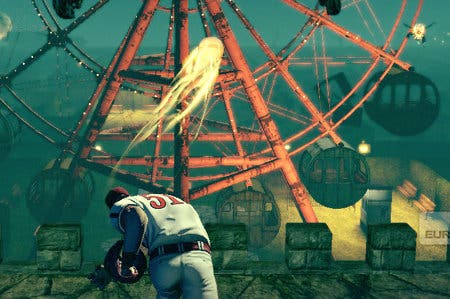Diabolical Pitch Review
Take me out at the ball game.
Oh Kinect, you giveth, but you taketh away. You're a bit like the good lord in that respect, really - except you generally limit your supernatural interventions to the world of video games. That's probably for the best.
Diabolical Pitch is a really good example of Kinect giving and taking, as it happens. Streamlined for Microsoft's motion sensor, Grasshopper's latest is designed around the kind of simple pleasures that you're only allowed to aim for when you're locked into the still rather primitive world of gesture inputs and body recognition. At the same time, though, the device's slight wonkiness when it comes to, y'know, gesture inputs and body recognition means that the game's never as much fun as it could be. Kinect is what makes Diabolical Pitch special, in other words, but it's also what makes it annoying.
Good stuff up first. I love the premise. In Diabolical Pitch, you're a superstar baseball player and you've injured your shoulder. Then, quick as a flash, you're hit by a car. When you wake up, you've been transported to a creepy fairground vision of the afterlife. Handed a brand new arm - don't worry, lefties, you can pick which side it goes on - your job is to take out hordes of monstrous weirdos by whacking them around with baseballs.
It's a great set-up for a wave-based arcade game: you're right there at the centre of the screen while enemies pop up in the distance. It's basically Wild Gunman, which means Marty McFly would be on board, but you're beaning the baddies with curveballs instead of blasting them with a six-shooter.
Happily, if Diabolical Pitch gets one thing absolutely right, it's that crucial sense of connection. There's a lovely crisp WHACK as your ball hits its target, while enemy models crumple, tumble, and even get a case of the cartoon spinning noggin if you pull off a headshot. (Most of your foes take the form of decrepit mascots, incidentally, so expect to face off against mouldy tigers, threadbare gorillas, and weird flying things that I guess are birds of some kind. No matter, you're there to batter them all equally.)
It's simple fun, but there are a handful of complications. Every now and then an enemy will throw something back your way - a saw blade to duck or jump over perhaps, or a bomb to catch in your mitt - while each level ends with a boss that might be an angry elephant in a UFO, say, or might be a panda whose body is a cannon. Throughout the game you earn baseball cards that work as perks, too, snipping away at cooldowns, boosting scores, or opening up new special pitching powers. These range from an electrical shot that arcs between foes to a fancy mystical bat - the wooden kind - and even a series of cannonballs. All of them come with rewarding animations, and all of them require special gestures to pull off, after you've charged up their energy with standard kills.
As the enemies shamble closer, you can see the design team's arcade smarts in the wave design, the themed backgrounds, the ability to ricochet balls off targets, or even the way you can earn a phantom catcher who drops by to get you out of trouble. You can feel the love for the central premise in the babble of one-armed bandit sound effects, the bars, lucky sevens and cherries you collect in each level, and the constant cheers of big wins and penny victories that seems to echo in your ears as you play. Lovely work. Enter Kinect.
Kinect, remember, is what makes that wonderful pitching idea possible, but it's also what threatens to bring the game to its knees on occasion. Although I imagine that you're theoretically meant to loosely target your shots to different parts of the screen, for example, the assists have to be so generous that it's basically assigning priorities for you, and you can get through most of the levels by just spamming the same movement. It's fun for a few minutes on a stress-relief kind of way, but it gets old rather quickly.
Look at some of the tiny, seemingly throwaway, design elements, meanwhile, and you'll see a smart team wrestling with annoying hardware on every level. There's a kick move for space-clearing that may well have been added because throws often don't register, meaning that enemies often swarm you. There's a cooldown in place if you throw too frequently, because the designers realise most people will simply perform the same gesture over and over and over again.
Then, to add a little complexity to a game which is handling most of the skillful stuff on your behalf, you get enemies who need specific body parts targeted to take them down, or who fire little rockets at you. This requires you to enter lock-on mode, and you do this by holding out your non-pitching arm and painting the targets with a crosshair. It's annoying to pull off, the game often fails to recognise what you're actually trying to do, and even when it does work, it doesn't feel like baseball. So what's the point of including it?
There's local multiplayer available if you want to rupture tendons with a friend - it's quite fun, and a great way to brute-force those single-player bottleneck moments - and the campaign takes you through a range of different environments, each with their own twists. The narrative, needless to say, is delivered with Grasshopper's typical sense of wit and style: each line of dialogue is delivered like a punch in the nose, and every few seconds something wonderfully odd happens.
I don't hate Diabolical Pitch by any means, in other words. I really want to love it, actually, and I certainly like a lot of things about it, from the lovely sense of fairground Americana to the fact that I've been walking around all week with a genuine case of pitcher's elbow. In what's turning out to be a regular Kinect refrain, then, try not to think of this as a flawed game so much as one that's been quietly and consistently undermined by its hardware.




